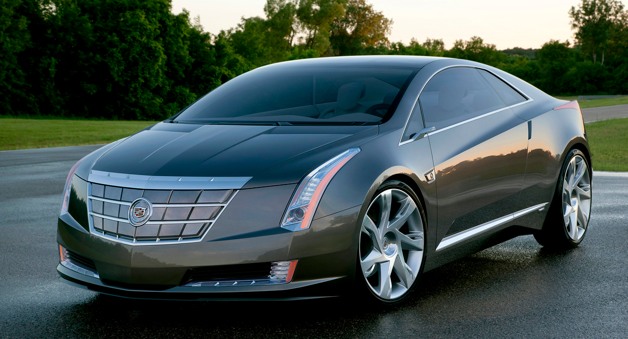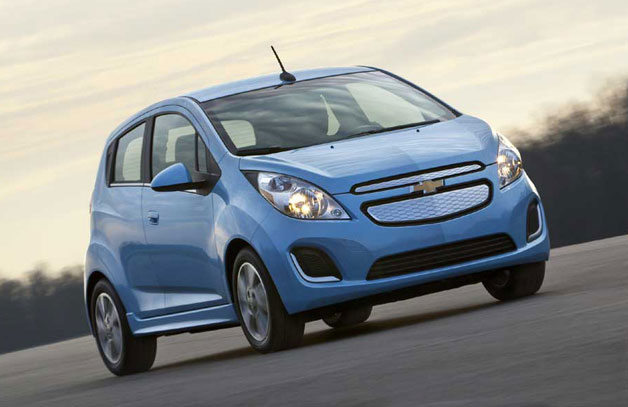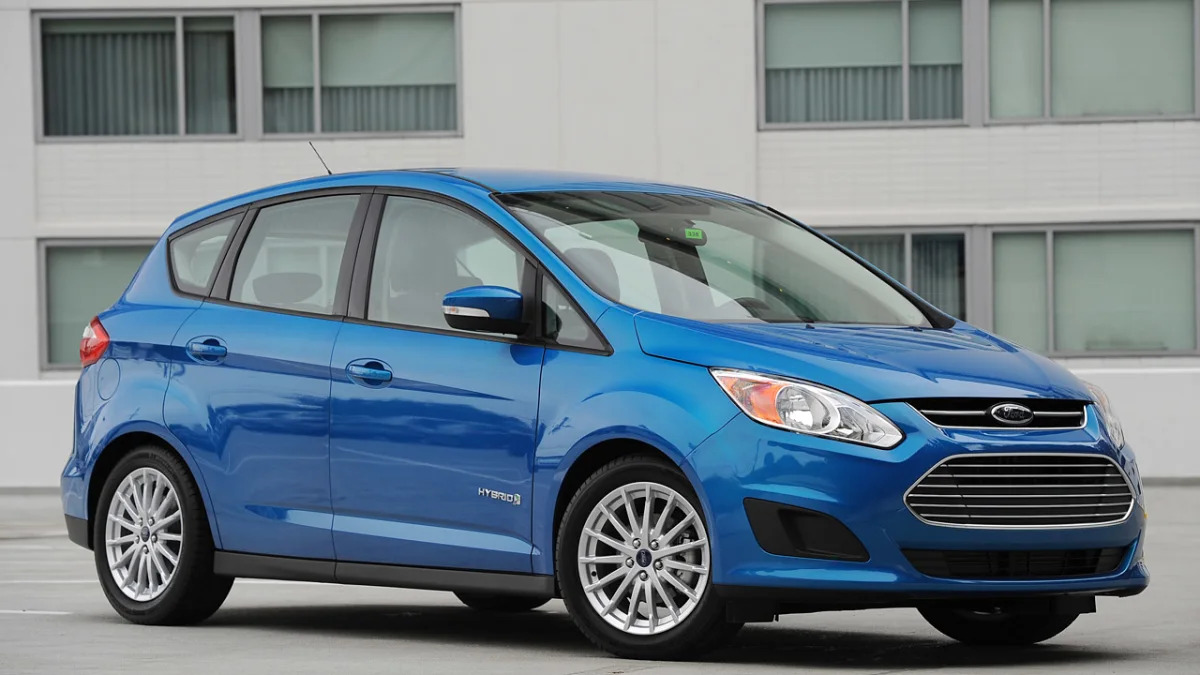It was lucky for me that GM's recent media forum on its electrification efforts was in San Francisco, since I would already be there for the press launch for the Ford C-Max Energi plug-in hybrid. And GM promised a session with its new global product guru, Mary Barra, and a brief drive of a prototype 2014 Chevy Spark EV.
Ford C-Max Energi
The C-Max is Ford's answer to the Toyota Prius – especially the more cargo-capable Prius V – and the plug-in Energi version takes on the Prius plug-in and trumps it in a number of ways, including performance, dynamics, EV range and efficiency.
Ford says the C-Max Energi can deliver up to 620 miles total range on a fully-charged battery and a tank of gas, topping the Prius plug-in's claimed 540. It offers 15 class-exclusive features, including Ford's hands-free liftgate (swing your foot under it and up it goes) and Active Park Assist (it chooses a suitable parallel spot and steers you into it) and a choice of three EV modes: EV Now (electric only), EV Later (saves battery for when you prefer to use it) or EV Auto (blends).
It's a nice-looking, nice-driving compact crossover that effectively hides its hybridness while delivering impressive efficiency for its size. Aside from its hybrid price premium ($33,745, and it qualifies for a federal tax credit worth up to $3,750), its only real downside is a high rear load floor over its 7.6-kWh li-ion battery pack, which cuts cargo capacity to 19.2 cu. ft. from the regular C-Max's 24.5 and (when loaded) can obstruct rear visibility.

GM Electrification
Mary Barra's media session turned out to be by satellite, not in person, and her Q&A yielded mostly company-line responses. Still, she laid out the basics of where GM is going.
She said that GM would pursue fewer vehicle electrification technologies vs. its former "cover all bases" approach. These will include a lot of eAssist "mild" hybrids on one end of the cost and complexity spectrum and more Voltec extended-range EV applications on the other. Coming in a year or so is the sexy Cadillac ELR, and – since this EREV technology is "scaleable" – we'll see more down the road in different vehicle sizes and types. I'm a big believer in this "pure EV first, gas generator later" approach, but it is expensive.
Barra added that Voltec technology will be a core piece of GM's electrification strategy, that the team has accumulated a lot of expertise in batteries, motors, controls and other EV technologies, and that the Spark EV and other future vehicles will share many of them, including charging, battery-management and cooling systems, motor controls and high-voltage connections. That will drive down costs and lead to eventual EV profitability. GM will sell more than 50,000 vehicles with some form of electrification (Volts and eAssist Chevys and Buicks) in 2012, and she predicted up to 500,000 GM electrified vehicles on the global road by 2017.
"What started out as a technology proof point ... has turned into a real-world starting point to push EV technology further and faster than we thought possible five years ago," she said. "The unique propulsion technology pioneered in the Volt will be a core piece of our electrification strategy going forward."

Spark EV
In one session of the 1-1/2-day program, GM showed off its new state-of-the-art propulsion motor, which will power the Spark and future GM electric vehicles. "Electric motor development and manufacturing is another area of expertise we need as we grow our portfolio of electric vehicles to address the needs of our global customers," said GM vehicle electrification engineering executive director Larry Nitz.
Another session demonstrated a joint project with technology company ABB that will explore repackaging used Volt batteries to provide stand-by power to homes. Another showcased two new GM OnStar EV apps: The Spark EV Way Point tab will tell an EV driver whether he/she can reach a destination on a single charge or provide a "waypoint" route with recommended charge stations if needed; and a Park-Tap-Charge app will allow EV drivers to tap a smart-phone against a charging station to show payment options and start the flow of electricity.
Given its 400-lb-ft of right-now torque and sub-eight-second 0-60 mph quickness, it is definitely fun. No range number yet, but it'll be competitive (100 miles or better), and Russell says it can be DC high-voltage charged repeatedly without harming its battery. It should appeal to urban dwellers without long-trip needs and some others with second vehicles in their fleets.
Ford C-Max Energi
The C-Max is Ford's answer to the Toyota Prius – especially the more cargo-capable Prius V – and the plug-in Energi version takes on the Prius plug-in and trumps it in a number of ways, including performance, dynamics, EV range and efficiency.
Billed as "America's most fuel-efficient plug-in hybrid," it offers 188 (gas/electric combined) horsepower vs. the plug-in Prius' 134 and 100 combined MPGe (equivalent) EPA economy vs. the Prius' 95. Ford also claims an electric-only range of "up to" 21 miles vs. the Toyota's 15, although both fall short of those numbers in real-life driving. The C-Max Energi typically starts its engine at 12 or 13 miles, the Prius plug-in at six or seven.The plug-in C-Max Energi takes on the Prius plug-in and trumps it in a number of ways.
Ford says the C-Max Energi can deliver up to 620 miles total range on a fully-charged battery and a tank of gas, topping the Prius plug-in's claimed 540. It offers 15 class-exclusive features, including Ford's hands-free liftgate (swing your foot under it and up it goes) and Active Park Assist (it chooses a suitable parallel spot and steers you into it) and a choice of three EV modes: EV Now (electric only), EV Later (saves battery for when you prefer to use it) or EV Auto (blends).
It's a nice-looking, nice-driving compact crossover that effectively hides its hybridness while delivering impressive efficiency for its size. Aside from its hybrid price premium ($33,745, and it qualifies for a federal tax credit worth up to $3,750), its only real downside is a high rear load floor over its 7.6-kWh li-ion battery pack, which cuts cargo capacity to 19.2 cu. ft. from the regular C-Max's 24.5 and (when loaded) can obstruct rear visibility.
When I tested a Ford C-Max for several days, it delivered 34.2 real-world mpg – not bad but nearly 13 mpg fewer than its 47-mpg EPA "combined" rating. My Fusion Hybrid experience gave a 35.6-mpg average vs. 47 combined, my week with a Toyota Camry Hybrid yielded 34.7 mpg vs. 40 combined, and my test of a Prius C logged 39.8 mpg vs. 50 combined. Hmmm.When I tested a Ford C-Max, it delivered 34.2 mpg – nearly 13 mpg fewer than its 47-mpg EPA rating.

GM Electrification
Mary Barra's media session turned out to be by satellite, not in person, and her Q&A yielded mostly company-line responses. Still, she laid out the basics of where GM is going.
She said that GM would pursue fewer vehicle electrification technologies vs. its former "cover all bases" approach. These will include a lot of eAssist "mild" hybrids on one end of the cost and complexity spectrum and more Voltec extended-range EV applications on the other. Coming in a year or so is the sexy Cadillac ELR, and – since this EREV technology is "scaleable" – we'll see more down the road in different vehicle sizes and types. I'm a big believer in this "pure EV first, gas generator later" approach, but it is expensive.
In between will be the Spark EV arriving next summer, and further out may be hydrogen fuel cell EVs and gas/electric parallel hybrids, though the latter seem a lower priority than EREVs. GM has decided that if you're going to tote around both an electric traction motor and a gasoline engine, it's more energy efficient to use just the former until the battery runs low, then fire up the latter only if needed, rather than blend the two depending on conditions. The EREV downside is that it needs a much bigger, and therefore more expensive, battery.I'm a big believer in this "pure EV first, gas generator later" approach, but it is expensive.
Barra added that Voltec technology will be a core piece of GM's electrification strategy, that the team has accumulated a lot of expertise in batteries, motors, controls and other EV technologies, and that the Spark EV and other future vehicles will share many of them, including charging, battery-management and cooling systems, motor controls and high-voltage connections. That will drive down costs and lead to eventual EV profitability. GM will sell more than 50,000 vehicles with some form of electrification (Volts and eAssist Chevys and Buicks) in 2012, and she predicted up to 500,000 GM electrified vehicles on the global road by 2017.
"What started out as a technology proof point ... has turned into a real-world starting point to push EV technology further and faster than we thought possible five years ago," she said. "The unique propulsion technology pioneered in the Volt will be a core piece of our electrification strategy going forward."

Spark EV
In one session of the 1-1/2-day program, GM showed off its new state-of-the-art propulsion motor, which will power the Spark and future GM electric vehicles. "Electric motor development and manufacturing is another area of expertise we need as we grow our portfolio of electric vehicles to address the needs of our global customers," said GM vehicle electrification engineering executive director Larry Nitz.
Another session demonstrated a joint project with technology company ABB that will explore repackaging used Volt batteries to provide stand-by power to homes. Another showcased two new GM OnStar EV apps: The Spark EV Way Point tab will tell an EV driver whether he/she can reach a destination on a single charge or provide a "waypoint" route with recommended charge stations if needed; and a Park-Tap-Charge app will allow EV drivers to tap a smart-phone against a charging station to show payment options and start the flow of electricity.
Then came the Spark EV drive. Chevy's Spark is a sporty four-door mini with a usable back seat and cool connectivity capabilities, and the EV version replaces its 1.25-liter gas four-banger with the 100-kW (130-hp) GM electric motor and a 20+ kWh lithium ion battery. "We knew we had to provide surprising fun-to-drive acceleration with maximum efficiency," said chief engineer Chuck Russell.Given its 400-lb-ft of right-now torque and sub-eight-second 0-60 mph quickness, it is definitely fun.
Given its 400-lb-ft of right-now torque and sub-eight-second 0-60 mph quickness, it is definitely fun. No range number yet, but it'll be competitive (100 miles or better), and Russell says it can be DC high-voltage charged repeatedly without harming its battery. It should appeal to urban dwellers without long-trip needs and some others with second vehicles in their fleets.










Sign in to post
Please sign in to leave a comment.
Continue